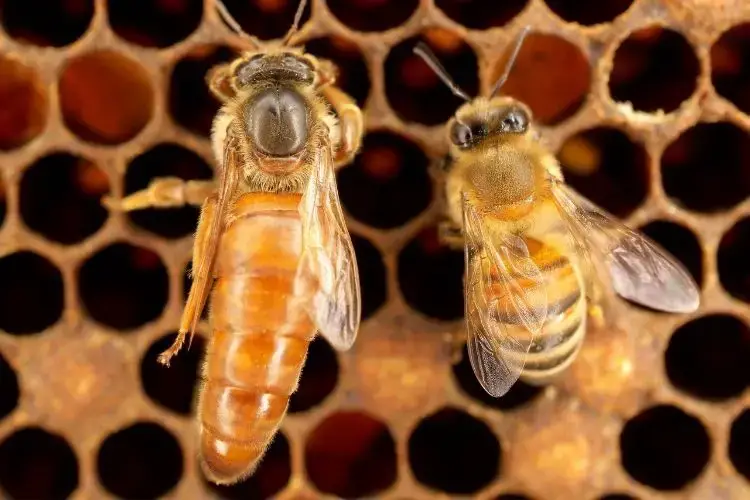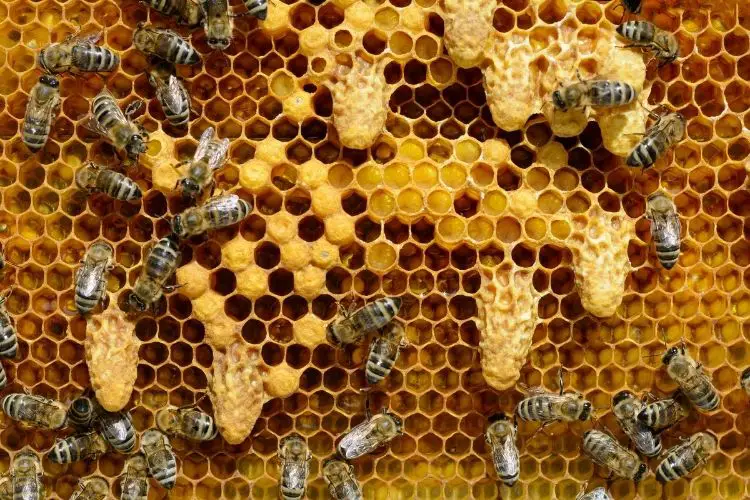what happens to bees when they cant get back into the hive
Premature queen loss is one of the most common reasons for colony failure noted by beekeepers in both the U.s. and Europe.
The queen honeybee has an essential role in the colony. She is the but fellow member that can lay fertilized eggs to produce more worker bees.

As the colony'southward female parent, a queen's characteristics profoundly influence the colony's performance and fertility potential.
And then, what happens if you kill a queen bee? What will happen to other members in the hive? Volition they enhance a new queen or carelessness the hive altogether?
Queen Bees And Colony Organization
Queens in social species similar ants, wasps, and honeybees ship signals that ensure she is the only one with the ability to reproduce among workers.
These signals are called primer pheromones. They inform workers of the queen's presence and inhibits reproduction in workers. If the queen is removed, workers will commencement raising a new queen or laying eggs themselves.
In honeybees, the queen mandibular gland pheromone (QMP) is the chief primer pheromone that prevents queen replacement.
This pheromone moves from the queen to the residue of the colonies through messenger bees that surround the queen and lick or use their antennae to capture the pheromone and distribute it to other workers.
In the absenteeism or reduction of this pheromone, workers start developing ovaries after a short time and begin laying eggs. This tin happen within 6 to thirty days, depending on what kind of bee they are.
Nonetheless, these laying workers cannot guarantee the growth and survival of the colony because they can't produce fertilized eggs that volition result in more worker bees.
The eggs from worker bees are always unfertilized, so the bees that hatch from these eggs are only males, also known equally drones.
Eventually, a colony without a queen or eggs to supersede her volition die.
How Long Will Bees Stay In A Hive Without A Queen?
When a colony of honeybees loses the queen (and fails to supersede her), queen-laid eggs no longer exist. This means no new workers will be raised, and the old ones will start to attain the finish of their life cycle.
The lifespan of a worker depends on the time of the yr. They usually live ii to six weeks in the summer and up to xx during wintertime.
This means the colony's size can decrease significantly if at that place'southward no queen bee laying more eggs. If a colony is left queenless, the colony could disappear entirely merely a few months subsequently the final egg was laid.
Worker Bees Drift To Other Colonies Later on Their Hive Is Left Queenless
Besides developing reproductive organs in workers, some go out the hive and move to a new colony.
A 2017 study looked into how worker honeybees' fertility and drifting behavior can exist influenced by the presence and relatedness to the queen in both their colony of origin and other surrounding colonies.
In the experiments, researchers had colonies nether three different queen states:
- Queenright colonies – had their queen, who was left untouched.
- Temporary queenless colonies – had their queen removed when brood was placed in an incubator and later raised a new queen.
- Hopelessly queenless colonies – the queen and all queen cells were removed to prevent the colony from raising a new queen.
The queen state of the colonies was an important factor in emitting drifting workers and receiving drifting honeybees.
Nearly workers that drifted were from queenright or temporary queenless colonies and were more likely to bring together a hopelessly queenless colony.
Consistent with previous enquiry, workers that came from queenright colonies showed the least ovary activation. However, they received very few drifting bees, fifty-fifty though they emitted about one-fourth of drifted workers in the experiment.
The temporary queenless colonies showed many fertile worker bees, and half of all the drifting workers came from this colony. Almost of these bees ended in hopelessly queenless colonies.
Additionally, they plant that the physical distance between colonies afflicted drifting behavior significantly – globe-trotting workers tended to go to those colonies closest to their ain.
So, what does all of this mean for your beehives?
Before long after they become queenless, y'all might notice a reduction in the population of worker bees, not only because there isn't a queen laying new eggs only also considering some of them will cull to drift to other colonies, especially if you lot accept beehives at a curt distance from each other and is also queenless.
Will A Queenless Hive Raise A New Queen?
A queenless colony of honeybees can raise their own queen without the help of a beekeeper if there are fertilized eggs nowadays. But if there is no breed, the days of the colony are numbered, and a new queen will have to exist introduced through man intervention.
Considering the queen bee has a vital part in guaranteeing the colony'south survival, honeybees have ways to avoid finding themselves queenless. Equally soon as they discover a problem with the queen, they will start rearing new queens.
Nevertheless, depending on the time of the year, letting the colony raise a new queen by themselves could hateful risking having a weak colony earlier the common cold weather arrives.
Some beekeepers cull to requeen in one case a year to ensure the colony e'er has a potent queen laying eggs.
If requeening your hives is not for you, make sure always to check the condition of the queen during your inspections and so you can help your bees if they notice themselves queenless.
It is also a skillful thought to keep an heart on the brood and their unlike stages of development. This can end upwards making your life easier – more on that later!
How Long Before Bees Realize They Are Queenless?
A 2004 report looked at how worker bees modify after the queen bee was removed from their colony. It showed that workers react to the absence of the queen in less than 50 minutes.
Why 50 minutes?
Given this interval is similar to the maximum time the queen is abroad when she'south mating (45 minutes), researchers believe it's an adaptation mechanism.
The prolongation of the queen pheromone for 50 minutes can avert false alarms on the few occasions the queen has to leave the hive.
After this time, worker bees will offset selecting breed to be raised every bit potential new queens or lay eggs themselves equally a last, yet ineffective, endeavor to ensure the colony'due south survival.
In other words, bees want to exist absolutely sure the queen is gone for proficient earlier they take any desperate measures!
How Long Does It Take To Enhance A New Queen?
When in that location is brood, workers in a queenless colony volition start raising new queens before long later on. They will choose a few cells and begin nurturing the lucky ones with royal jelly.
Even though they use brood of all ages to raise new queens, research adamant they are more than likely to make queen cells effectually brood that were three days erstwhile when they became queenless.

Between days four and five, queen cells are capped, and at around days 12 to 13, a new queen virgin emerges. A week afterward, the virgin queen goes out to her first nuptial flying and starts mating with drones.
So, the time information technology takes for a new queen to first laying eggs and secure the colony'due south future tin be at least 20 days from the time they get queenless.
Whether this is presently plenty or not to salve the hive will depend on the time of the twelvemonth and the health of your colony.
While the sudden loss of a queen is usually an adverse event in the life of a beehive, becoming queenless shortly before the colder months can be catastrophic.
Always keep in mind how much time you and your bees have before winter before deciding whether to introduce a queen or let them raise their own.
How Do I Know If My Hive Is Queenless?
It'south common to wrongly assume a hive is queenless because of how difficult it tin can exist to locate the queen.
Here are signs that will help yous make up one's mind whether your colony is queenless or not:
- Presence of queen cells. If you see a structure that looks similar a peanut shell or simply a larger-than-usual cell effectually the heart of the comb, then it's probable emergency queen cells are being built.
- Absenteeism of eggs and brood. Queen bees tin lay up to 2,000 eggs a day during summertime, so if there is a significant subtract in the number of eggs and brood in the hive, there's a take chances the hive is queenless. Keeping a journal during your inspections can help yous tape this blazon of data. So, whenever you think at that place is something incorrect or dissimilar, y'all will exist able to ostend and cross-check the data in your journal.
- There are more drones than usual. This can signal your workers are laying eggs due to lack of queen mandibular pheromone maintaining reproductive control in the colony.
- A full general decline of worker bees. If your colony seems smaller than before, and you lot know they didn't swarm, your colony could be queenless.
- Your bees are suddenly aggressive . If you notice a sudden change of behavior in your colony, chances are your hive is queenless. Honeybees act differently when they are queenless as the queen influences reproduction and beliefs within her colony.
Summing Upward… What Happens When Y'all Impale A Queen Bee?
The queen plays an essential role in every honeybee colony. Not only do they regulate reproduction, but they also influence the behavior of all the bees in the hive.
When a queen bee dies, worker bees will try to enhance a new queen from the brood. It will accept workers around an hour to determine whether their queen has gone missing, and they volition begin building emergency queen cells to enhance a new 1.
When in that location is no brood available to rear a new queen, worker bees will outset laying eggs.
Unfortunately, these will be unfertilized, meaning they tin only event in drones. Therefore, the colony's survival is under threat and your timely intervention as a beekeeper is crucial.
Depending on the time of the year, you lot may decide whether letting your bees requeen themselves is a good thought or not. As a dominion of thumb, the closer it is to winter, the more than urgent replacing the queen will become.
castellanoslited1960.blogspot.com
Source: https://busybeekeeping.com/what-happens-if-you-kill-a-queen-bee/
0 Response to "what happens to bees when they cant get back into the hive"
Post a Comment